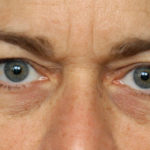Frowning is a very common human facial movement that can indicate a variety of expressive emotions. Most commonly, it suggests concern, concentration and even anger. As the eyebrows move closer together, a pair of vertical lines or grooves develops between them. Known as glabellar furrows, these indentations start out as appearing only when one is making an expression. Over time with repeating impressions on the skin, these glabellar furrows become etched into the skin and are present even when one is making no expression at all.
Glabellar furrows are the result of complex muscle movements, six in total, that converge to pull the eyebrows inward. This common, but undesired, facial expression is one of the main reasons that Botox became a cosmetic injection treatment. While Botox is tremendously effective, its results are only temporary.
More permanent solutions to glabellar frowning can be done through a corrugators myotomy (partial muscle release) or a myectomy. (complete muscle resection) Altering the paired corrigator muscles is often a part of browlift surgery or a modifications of it.

But what if one doesn’t need a formal browlift? Glabellar muscle resection can still be done using the endoscopic browlift technique….but without lifting the brow. Is this treatment worth the surgical effort? No long-term studies have ever been published on its effectiveness but, in my Indianapolis plastic surgery practice, I have performed it occasionally. My observations is that its eventual results are not as profound as Botox but some permanent muscle activity is obtained.
Endoscopic corrugator (and procerus) muscle resection is also a good option to consider when one has recurrent migraines that are proven to eminate from the supraorbital and supratrochlear frontal nerves. Relief with Botox injections is a good diagnostic test to verify that muscle resection could provide some long-term migraine reduction. In a few cases, I have had medical insurance pay for this endoscopic treatment although this would be uncommon as it is not a procedure yet reviewed as the standard of care for this problem.
Dr. Barry Eppley
Indianapolis, Indiana



